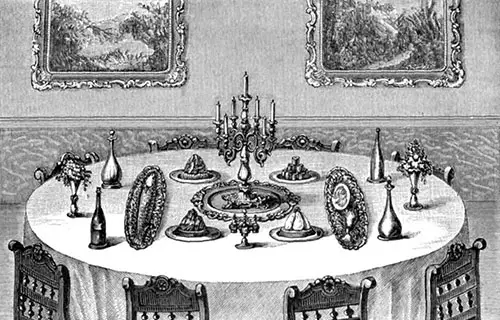French Table Service - 1916

FRENCH SERVICE (Service à la Française)
There are two different services in use: The French and the Russian.
Although recognizing the priority of both services, it will be well to mention the difference existing between them and the English and the American service; first, they differ in the classification of the bills of fare and certain changes in the table service, these alone are enough to be interesting.
The old style of French service threatens to disappear entirely and is rarely used, except on very rare occasions.
The three services placed on the table, one after the other, had certainly the advantage of displaying the culinary labor as well as the most various and rare products by exhibiting them in all their profuseness.
But the great inconvenience is the preparation of dishes beforehand in the kitchen in order to have each service ready at once and to keep them hot in heaters before beginning to serve the dinner.
The dishes for the first course are placed on the table in chafing dishes provided with covers, to be lifted off when the guests are seated and left on the table till ready to be carved.
Of course, this inconvenience is somewhat remedied by keeping the heaters and chafing dishes at a given heat, and there must be placed near the table, either behind a screen in the dining room or else in an adjoining pantry, a bain-marie with all the necessary sauces required for the dinner, and as soon as the meats are carved, each one is to be covered with its respective sauce before being handed around.
But notwithstanding all possible care and attention the entrées are apt to lose much of their finer qualities by the very act of being cooked and dressed beforehand, then kept hot in these heaters or chafing dishes.
Still, this could scarcely have been the sole cause for abandoning the old system, for it continued in usage for several centuries. We are, however, obliged to recognize that first-class families have ceased to make a display of the great luxuriousness indulged in, in the past.
Today they are more restrained, the helpless numerous and the chief cook frequently alone with one kitchen assistant, having no longer an extra man for pastry, confectionery, and ices.
The chef himself must see to the preparation of the pastry, ices, and desserts. There is now scarcely to be found any house where for twelve persons they employ a chef, an assistant and a pastry cook and the remainder of the help corresponding to this great amount of luxury.
The bills of fare are simpler; instead of dressing and arranging the service on the table itself, many houses have a mixed service; this is made by presenting the dishes on the table, then removing them to be carved.
The general desire of the day is to dine quicker; taste changes with the fashion. The old French service is fast disappearing, and as it becomes simpler, it gradually evolves into a mixed Russian and French service.
